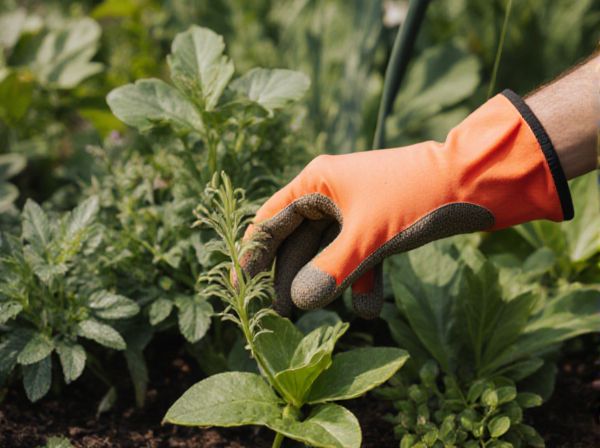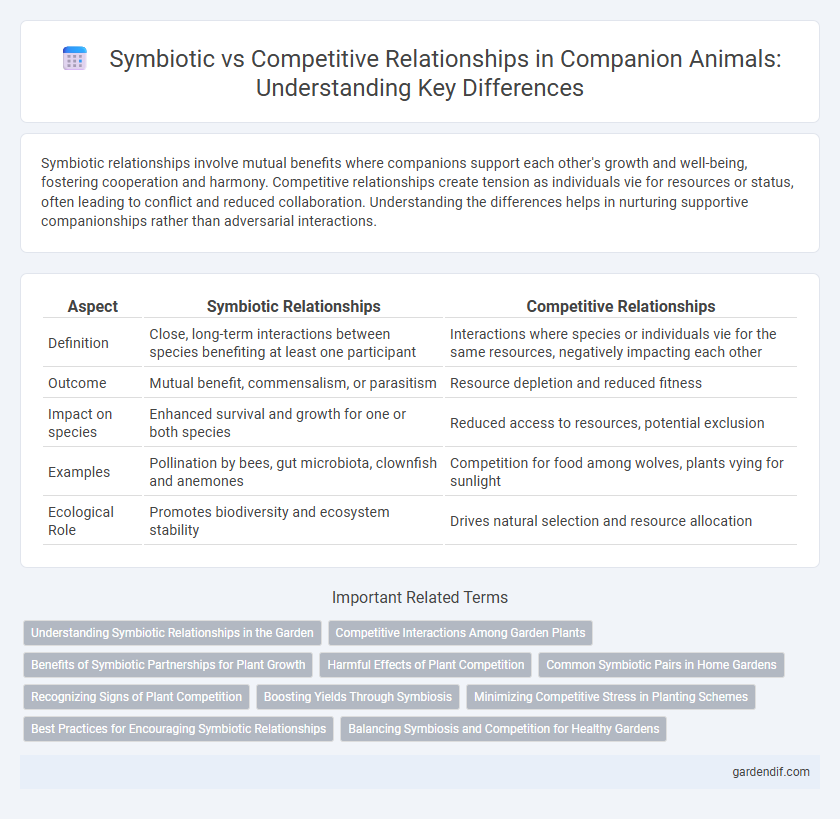
Symbiotic relationships vs competitive relationships Illustration
Symbiotic relationships involve mutual benefits where companions support each other's growth and well-being, fostering cooperation and harmony. Competitive relationships create tension as individuals vie for resources or status, often leading to conflict and reduced collaboration. Understanding the differences helps in nurturing supportive companionships rather than adversarial interactions.
Table of Comparison
| Aspect | Symbiotic Relationships | Competitive Relationships |
|---|---|---|
| Definition | Close, long-term interactions between species benefiting at least one participant | Interactions where species or individuals vie for the same resources, negatively impacting each other |
| Outcome | Mutual benefit, commensalism, or parasitism | Resource depletion and reduced fitness |
| Impact on species | Enhanced survival and growth for one or both species | Reduced access to resources, potential exclusion |
| Examples | Pollination by bees, gut microbiota, clownfish and anemones | Competition for food among wolves, plants vying for sunlight |
| Ecological Role | Promotes biodiversity and ecosystem stability | Drives natural selection and resource allocation |
Understanding Symbiotic Relationships in the Garden
Symbiotic relationships in the garden involve mutually beneficial interactions between plants, insects, or microorganisms, such as nitrogen-fixing bacteria partnering with legumes to enhance soil fertility. These cooperative interactions improve plant health, boost growth, and increase resistance to pests and diseases. Understanding these relationships helps gardeners optimize companion planting strategies that foster balanced ecosystems rather than fostering competitive struggles for resources.
Competitive Interactions Among Garden Plants
Competitive interactions among garden plants significantly impact growth and yield by limiting access to essential resources such as sunlight, water, and nutrients. Species with similar niche requirements often engage in competition, resulting in stunted development or reduced productivity for less dominant plants. Understanding these competitive dynamics enables gardeners to select compatible plant combinations that minimize resource overlap and enhance overall garden vitality.
Benefits of Symbiotic Partnerships for Plant Growth
Symbiotic relationships in plants enhance nutrient absorption, improve resistance to pests, and increase overall growth rates by facilitating mutual exchanges between species, such as mycorrhizal fungi aiding root nutrient uptake. These partnerships optimize resource utilization and foster healthier ecosystems compared to competitive relationships, which often limit access to light, water, and nutrients. Research shows that symbiotic plant associations contribute significantly to soil health and crop yield stability, underscoring their importance in sustainable agriculture.
Harmful Effects of Plant Competition
Symbiotic relationships in plants often enhance nutrient absorption and growth, whereas competitive relationships lead to resource depletion, stunted development, and reduced biodiversity. Plant competition for sunlight, water, and soil nutrients can cause significant harm by weakening individual plants and increasing vulnerability to diseases and pests. These harmful effects ultimately disrupt ecosystem stability and decrease overall plant productivity.
Common Symbiotic Pairs in Home Gardens
Common symbiotic pairs in home gardens include legumes and nitrogen-fixing bacteria, which enrich soil fertility by converting atmospheric nitrogen into usable forms for plants. Mycorrhizal fungi form mutualistic associations with plant roots, increasing water and nutrient absorption while receiving carbohydrates. Certain plants, such as marigolds and tomatoes, exhibit competitive relationships by producing allelopathic chemicals that inhibit the growth of neighboring weeds and pests.
Recognizing Signs of Plant Competition
Symbiotic relationships involve mutually beneficial interactions between plants and their companions, enhancing growth and resource sharing. Recognizing signs of plant competition includes observing stunted growth, yellowing leaves, and reduced flowering, which indicate struggle for nutrients, light, or water. Effective garden management identifies these stress signals early to adjust companion planting strategies and maintain ecosystem balance.
Boosting Yields Through Symbiosis
Symbiotic relationships in companion planting enhance crop yields by promoting nutrient exchange, improved pest resistance, and efficient resource utilization between paired plants. For example, legumes fix nitrogen in the soil, benefiting neighboring crops like corn, which in turn provide structural support or shading. This mutualistic interaction results in healthier plants and higher productivity compared to competitive relationships, where plants vie for limited resources, often diminishing overall yield.
Minimizing Competitive Stress in Planting Schemes
Symbiotic relationships in planting schemes enhance nutrient exchange and improve plant health by fostering mutual benefits between companion species, reducing competition for resources. Minimizing competitive stress involves selecting plant pairs with complementary root depths, nutrient requirements, and growth habits to optimize resource use without crowding or overshadowing each other. Implementing such strategic combinations increases overall productivity and resilience in garden ecosystems by promoting coexistence rather than rivalry.
Best Practices for Encouraging Symbiotic Relationships
Encouraging symbiotic relationships requires fostering mutual benefits and clear communication to ensure each companion's needs are met and valued. Establishing trust and cooperation through shared goals and regular positive interactions helps maintain balance and reduces conflicts. Implementing supportive environments and encouraging empathy strengthens the partnership, promoting sustainable coexistence over competitive rivalry.
Balancing Symbiosis and Competition for Healthy Gardens
Symbiotic relationships in gardens enhance plant growth through mutual benefits like nutrient exchange and pest control, while competitive relationships can limit resources such as light, water, and soil nutrients. Balancing symbiosis and competition involves selecting companion plants that complement each other's needs and growth habits, promoting biodiversity and resilience. Optimizing this balance fosters healthy garden ecosystems, improves yield, and reduces the need for chemical interventions.
Symbiotic relationships vs competitive relationships Infographic

 gardendif.com
gardendif.com